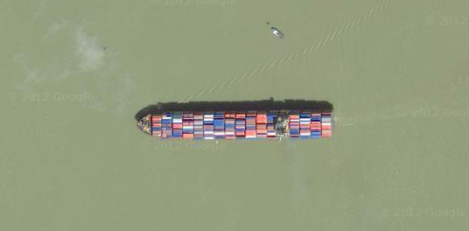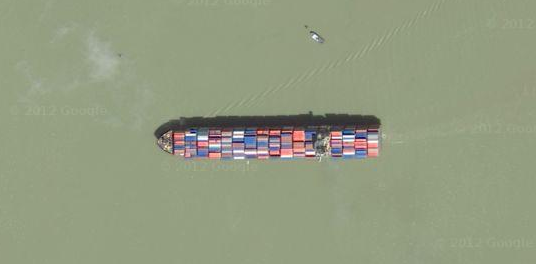Granted, it cost 5,600 workers their lives and the U.S. had to encourage a revolution to make it happen, but the building of the Panama Canal dramatically reshaped how commerce moved around the world. Instead a long, dangerous trip around the southern tip of South America, ships could traverse a calm (tropical!) waterway. It brought new competition to the then-dominant railroad industry forcing price reductions for coast-to-coast transport.
It was completed almost a century ago, opening on August 15, 1914. In the intervening 98 years, ships have gotten bigger, the cargo load has grown, and the Panama Canal’s locks, which raise and lower ships, have become a chokepoint.

A ship navigates the canal, as seen on Google Maps.
So in 2014, during the canal’s centennial, Panama will open a third lane for transit, including a set of new, bigger locks.
When the third lane opens in late 2014, the canal’s capacity will more than double. Ships as long as 1,200 feet and up to 160 feet wide, with drafts as deep as 50 feet, will be able to transit. The largest vessels will carry as many as 13,200 containers, or at least double the dry weight of bulk cargo that can pass through today.
Panamax vessels [Ed.: ships built for the canal’s current specifications] are long, slim and require a lot of water ballast to maintain balance. New mega-ships will be wider, more stable and will consume up to 16 percent less fuel — meaning a smaller environmental footprint and lower costs for their operators.
This last point is key. Freight ships are already far more fuel-efficient than other modes of transport. When shipping companies can use even-more-fuel-efficient ships, it will mean more cargo transported, less money spent on fuel — and possibly more business. For the rest of us, it means a big reduction in fossil-fuel use and carbon emissions.
The imminent opening of the third lane is having a ripple effect throughout transit hubs — on land and shore — worldwide.
The Panama Canal widening will affect inland railway hubs such as Kansas City and ports along the Gulf Coast, according to a study released in June by the U.S. Army Corps of Engineers. As shipping becomes cheaper, rail lines that handle cargo coming from Asia that is offloaded at Pacific ports and rolled across the country may notice a slowdown, it said.
Yet it will be a boon for the Midwest Farm Belt as grain exports moving through the Gulf Coast become more competitive in Asia, it said.
“This could have a significant impact on both the total quantity of U.S. agricultural exports and commodities moving down the Mississippi River for export at New Orleans,” the study predicted.
More goods will move through Texas ports, too, and motorists are certain to groan at clogged highways. Texas officials in May created the Panama Canal Stakeholder Working Group to figure out how such highways as I-35 between Dallas and San Antonio, which already handles some 200,000 vehicles a day, will cope.
The U.S., meanwhile, is working to make its own waters more friendly to cargo ships. Last month, the White House announced expedited plans for dredging harbors on the East Coast. New, larger ships draw more water than their older brethren, meaning that the waterways in major ports need to be deeper to accommodate them.

Photo by dsasso.
Businesses and governments are increasingly looking for ways to move huge quantities of goods without using much fuel. One company is working to develop a cargo ship that would use no fossil fuels at all; another is looking at using giant blimps to shunt cargo around the world. Interesting stuff — but a ways off.
In the meantime, a century after its opening, the Panama Canal is about to become a key component in the most efficient shipping system we’ve got.




